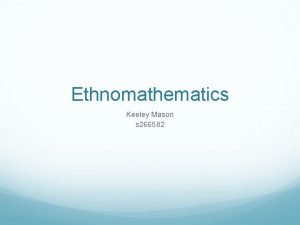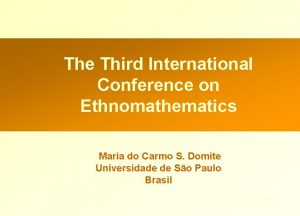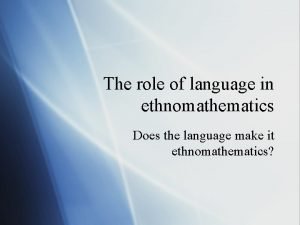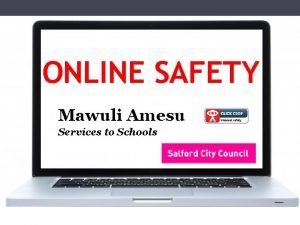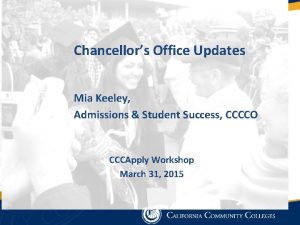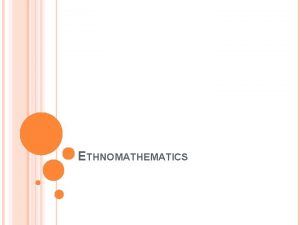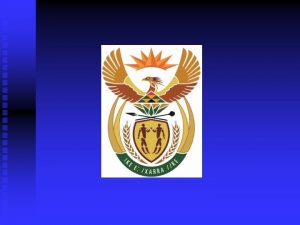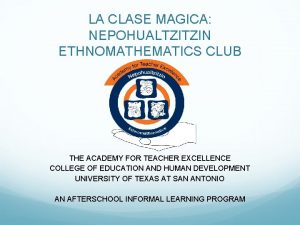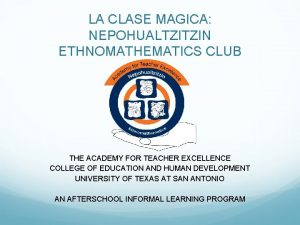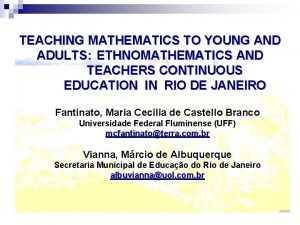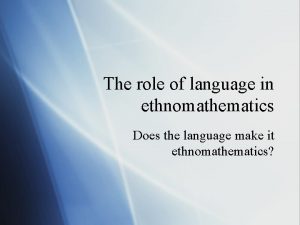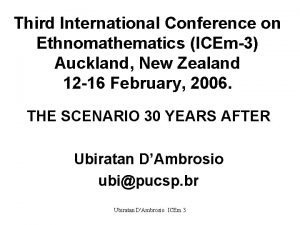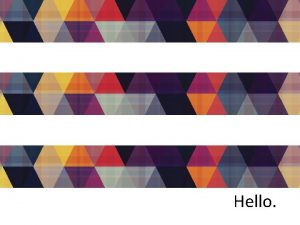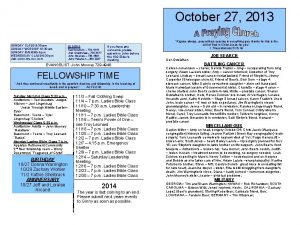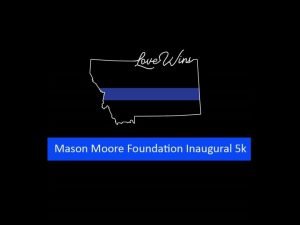Ethnomathematics Keeley Mason s 266582 The topic I















- Slides: 15

Ethnomathematics Keeley Mason s 266582

The topic I have chosen to critically examine and complete my presentation on is Ethnomathematics.

Initial thoughts on Mathematics and Culture My initial thought was that all mathematical processes are the same world wide. Why wouldn’t they be? I have only ever be taught the same processes from a young age and never thought to challenge these ideas and concepts. Culture and mathematics have a connection was never something I had put hand-inhand. They are two completely different topics that don’t have any relevance to each other. But once I began looking into Ethnomathematics, a topic I had never heard of, it become very clear that the mathematics I have always know originated from an array of cultures and that there are other mathematical ideas and concepts of different cultures. This presentation will explain what Ethnomathematics is and how it is relevant in the classroom and curriculum.

What is Ethnomathematics? Ethnomathematics when split into two words 'ethno' and 'mathematics' becomes easier to understand. Ethno is described as "all of the ingredients that make up the cultural identity of a group: language, codes, values, jargon, beliefs, food and dress, habits, and physical traits. " Mathematics expresses a "broad view of mathematics which includes ci hering, arithmetic, classifying, ordering, inferring, and modeling" (Ubiratan D'Ambrosio, 2001, p. 1). From these terms my understand is that Ethnomathematics is a term used to describe the connection between mathematics and culture. Ethnomathematics by Robert Hunter and Heather Whitely "mathematics used by a defined cultural group in the course of solving problems related to control of their environment” (as sited in John Rudder, 2017)

Ethnomathematics in the classroom provides a new aspect for mathematics and challenges what we believe to be the norms of mathematics. Academic mathematics is what is being taught in classrooms now, but is the only way of mathematics and is it truly universal and understood by all cultures? (Nienaber, 2010). No, mathematics can be taught using the ways of different cultures; some cultures understanding of mathematics is through their knowledge of the world around them. Ojibway and Inuit, hunting societies, use temporal units to measure distance such as days, sleeps and lunar phases, instead of standard units such as kilometer and miles (Denny, 1986 as sited in Nienaber, 2010). “Mathematics is not, as it is commonly believed, universally accepted and understood by all cultures” (Nienaber, 2010). Each culture has its own understanding of mathematics and this understanding and belief needs to be welcomed into the classroom.

Welcoming Ethnomathematics into the classroom Incorporating Ethnomathematics into the classroom setting is beneficial for students and teachers. Our mathematical concepts and ideals have emerged over time and students will understand where they have come from and compare these with the concepts and ideals of other cultures (Nienaber, 2010). Ethnomathematics in the classroom should not only result in better grades for students but also facilitate powerful mathematical process such as visualising mathematical situations, encouraging a sense of proportional size, recognising mathematics in practice, making links between home and school, and encouraging relevant, daily problem solving (Owens, 2016). Ethnomathematics is more than the connection of mathematics and culture, it can expand across many areas of the curriculum and broaden students understanding of different cultures. So that we are not limited to western perspective alone, its important to understand different ethnomathematical systems so we can enhance our greater understanding of mathematics (Owens, 2016).

Joseph (1997) states that “By connecting cultural meanings to mathematical concepts teachers can begin to relate these concepts to student's everyday lives. These relations can have applications in other disciplines as well, such as art, design, history, and social studies, and the students will have a deeper knowledge and better understanding of these concepts” (as sited in Nienaber, 2010).

Incorporating Ethnomathematics into lessons One way of incorporating Ethnomathematics into lesson is from an Indigenous perspective. The 8 Aboriginal ways of learning is a pedagogy framework that allows teachers to include Aboriginal perspectives by using Aboriginal learning techniques. Some common ground between mainstream and Aboriginal pedagogies, include: Learning through narrative. Planning and visualising explicit processes. Working non-verbally with self-reflective, hands-on methods. Learning through images, symbols and metaphors. Learning through place-responsive, environmental practice. Using indirect, innovative and interdisciplinary approaches. Modelling and scaffolding by working from wholes to parts. Connecting learning to local values, needs and knowledge (8 aboriginal ways of learning factsheet, 2012)

The 8 ways to develop Indigenous Cultural Competence?

Incorporating the 8 ways into lessons Symbols and Signs are one way of incorporating the 8 ways into lessons. One activity that can be done is using a symbol to represent rules in the classroom. A great example is a teacher creating a symbol for ‘Following Instructions’ that was a curved track with an adult footprint followed by a group of children’s footprints. This bought forward the realisation that the students needed to be following the teacher’s example, rather than the teacher chasing the students about their behaviour’ (Yunkaporta n. d. , p. 41). Aboriginal knowledge isn't always required, you can simply reframe a concept using the pedagogy framework – for example, innovating a balanced diet diagram based on the symbol for non-linear learning (Wiki, 17/06/09 as sited in Yunkaporta n. d. , p. 41).

Incorporating Ethnomathematics into lessons Ethnomathematics also fits well with other area within the curriculum for example The Arts; Sona drawings are traditional drawings from Congo, Angola and Zambia. These drawings are of Chokwe people telling a story (Charvey, 2010) and through these drawing mathematical terms such as symmetry, shapes, patterns and numbers can be discussed. The drawings are a one-line drawing form used for decorations but also used to transmit stories, lessons and moral and cultural values (Charvey, 2010) For an in-depth explanation on Ethnomathematics: Sona designs from Africa visit this You. Tube video by Darrah Chavey: https: //www. youtube. com/watch? v=ql. Xk. AB 2 ij. N 0

Ethnomathematics into the classroom To best benefit your students in the classroom with the use of Ethnomathematics is important that you know and understand the class you are teaching. If there are no students with a Greek background then they are less likely to relate to Greek mathematical ways. Therefore if you have a number of Aboriginal students then adopt the 8 ways of learning, this will benefit these students as well as the rest of the class. Vygotskys’ theory emphasizes the importance of society and culture for promoting cognitive development (Mc. Leod, 2007). He believed that adults in society foster children’s cognitive development, therefore its important to make children's learning relevant to them so that they can engage in their prior knowledge.

Connecting Ethnomathematics to the curriculum The curriculum has incorporated cultural pedagogies and understand the importance of this approach in the classroom. Key concepts that the Aboriginal and Torres Strait Islander people adopt that are addressed in the curriculum are Country/Place, Language and Diversity (ACARA, 2016). Ethical and Intercultural understanding are listed within the seven general capabilities in the curriculum. Ethnomathematics helps students to understand the importance of an inclusive classroom and supports them in understand the two general capabilities mentioned above (ACARA, 2016).

References 8 aboriginal ways of learning factsheet (2012) Available at: https: //intranet. ecu. edu. au/__data/assets/pdf_file/0016/510073/8 -Aboriginal-ways-oflearning-factsheet. pdf (Accessed: 16 February 2017). ACARA (2016) The Australian Curriculum. Available at: http: //www. australiancurriculum. edu. au (Accessed: 17 February 2017). D’Ambrosio, U. (2001, Feb). Teaching Children Mathematics. Retrieved Feb 13, 2017, from What is ethnomathematics and how can it help children in Schools? : http: //etnomatematica. org/articulos/Ambrosio 1. pdf Darrah Chavey (2016) Ethnomathematics: Sona designs from Africa. Available at: https: //www. youtube. com/watch? v=ql. Xk. AB 2 ij. N 0 (Accessed: 17 February 2017). Chavey, D. (2010) ‘Constructing Symmetric Chokwe Sand Drawings’, Symmetry: Culture and Science, 21(1 -3), pp. 191– 206. John Rudder. (2017). Introduction, Australian Institute of Aboriginal and Torres Strait Islander Studies. Retrieved 13 February 2017, from http: //aiatsis. gov. au/collections-online/digitised-collections/ethnomathematicsaustralia/introduction

References Mc. Leod, S. (2007) Lev Vygotsky. Available at: http: //www. simplypsychology. org/vygotsky. html (Accessed: 17 February 2017). Nienaber, A. (2010) ‘Ethnomathematics in the Classroom’, Saskatchewan Mathematics Teachers’ Society, 2(2), pp. 1– 64. Owens, K. (2016) Ethnomathematics. Available at: http: //www. nova. org. au/everything-else/ethnomathematics (Accessed: 16 February 2017). Yunkaporta, T n. d. Draft Report for DET on Indigenous Research Project conducted by Tyson Yunkaporta, Aboriginal Education Consultant, in Western NSW Region Schools, 2007 -2009: Aboriginal Pedagogies at the Cultural Interface, viewed 20 September 2012, <http: //8 ways. wikispaces. com/file/view/draft+report. doc>
